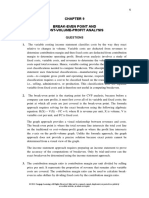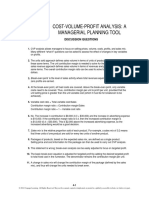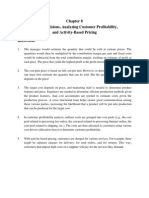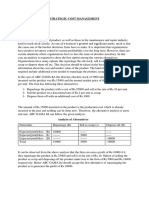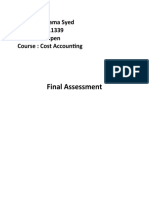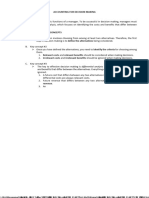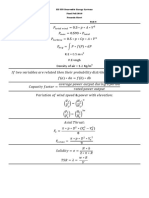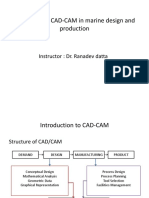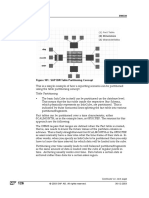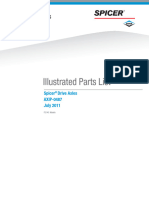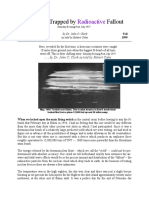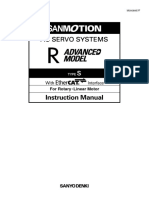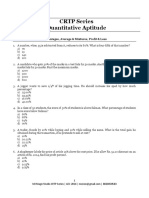Appendix A Pricing Products and Services
Appendix A Pricing Products and Services
Uploaded by
Javed AhmedCopyright:
Available Formats
Appendix A Pricing Products and Services
Appendix A Pricing Products and Services
Uploaded by
Javed AhmedOriginal Title
Copyright
Available Formats
Share this document
Did you find this document useful?
Is this content inappropriate?
Copyright:
Available Formats
Appendix A Pricing Products and Services
Appendix A Pricing Products and Services
Uploaded by
Javed AhmedCopyright:
Available Formats
To download more slides, ebook, solutions and test bank, visit http://downloadslide.blogspot.
com
Appendix A
Pricing Products and Services
Solutions to Questions
A-1 In cost-plus pricing, prices are set by the product. Full cost is an alternative approach
applying a markup percentage to a product’s not discussed in the chapter that is used almost
cost. as frequently as the absorption approach. Under
the full cost approach, all costs—including sell-
A-2 The price elasticity of demand measures ing and administrative expenses—are included in
the degree to which a change in price affects the cost base. If full cost is used, the markup is
unit sales. The unit sales of a product with in- only supposed to provide for an adequate return
elastic demand are relatively insensitive to the on the assets.
price charged for the product. In contrast, the
unit sales of a product with elastic demand are A-6 The absorption costing approach as-
sensitive to the price charged for the product. sumes that consumers do not react to prices at
all—consumers will purchase the forecasted unit
A-3 The profit-maximizing price should de- sales regardless of the price that is charged.
pend only on the variable (marginal) cost per This is clearly an unrealistic assumption except
unit and on the price elasticity of demand. Fixed under very special circumstances.
costs do not enter into the pricing decision at all.
Fixed costs are relevant in a decision of whether A-7 The protection offered by full cost pric-
to offer a product or service at all, but are not ing is an illusion. All costs will be covered only if
relevant in deciding what to charge for the actual sales equal or exceed the forecasted sales
product or service once the decision to offer it on which the absorption costing price is based.
has been made. Because price affects unit sales, There is no assurance that a sufficient number
total variable costs are affected by the pricing of units will be sold.
decision and therefore are relevant.
A-8 Target costing is used to price new
A-4 The markup over variable cost depends products. The target cost is the expected selling
on the price elasticity of demand. A product price of the new product less the desired profit
whose demand is elastic should have a lower per unit. The product development team is
markup over cost than a product whose demand charged with the responsibility of ensuring that
is inelastic. If demand for a product is inelastic, actual costs do not exceed this target cost.
the price can be increased without cutting as This is the reverse of the way most
drastically into unit sales. companies have traditionally approached the
pricing decision. Most companies start with their
A-5 The markup in the absorption costing full cost and then add their markup to arrive at
approach to pricing is supposed to cover selling the selling price. In contrast to target costing,
and administrative expenses as well as providing this traditional approach ignores how much cus-
for an adequate return on the assets tied up in tomers are willing to pay for the product.
.
© The McGraw-Hill Companies, Inc., 2010. All rights reserved.
Solutions Manual, Pricing Appendix 957
To download more slides, ebook, solutions and test bank, visit http://downloadslide.blogspot.com
Exercise A-1 (30 minutes)
1. Maria makes more money selling the ice cream cones at the lower price,
as shown below:
$1.89 Price $1.49 Price
Unit sales ...................... 1,500 2,340
Sales ............................. $2,835.00 $3,486.60
Cost of sales @ $0.43 ..... 645.00 1,006.20
Contribution margin ....... 2,190.00 2,480.40
Fixed expenses .............. 675.00 675.00
Net operating income ..... $1,515.00 $1,805.40
2. The price elasticity of demand, as defined in the text, is computed as
follows:
ln(1+% change in quantity sold)
d =
ln(1+% change in price)
æ2,340-1,500 ÷ ö
ln(1+ çç ÷
÷)
çè 1,500 ø
=
æ1.49-1.89 ÷
ö
ln(1+ çç ÷)
çè 1.89 ÷ ø
ln(1+0.56000)
=
ln(1-0.21164)
ln(1.56000)
=
ln(0.78836)
0.44469
= = -1.87
-0.23780
© The McGraw-Hill Companies, Inc., 2010. All rights reserved.
958 Managerial Accounting, 13th Edition
To download more slides, ebook, solutions and test bank, visit http://downloadslide.blogspot.com
Exercise A-1 (continued)
3. The profit-maximizing price can be estimated using the following formu-
la from the text:
æε ö
Profit-maximizing price = çç d ÷ ÷
÷Variable cost per unit
çè1+ε ø÷
d
æ -1.87 ÷ ö
= çç ÷$0.43
çè1+(-1.87) ÷
ø
= 2.1494 × $0.43 = $0.92
This price is much lower than the prices Maria has been charging in the
past. Rather than immediately dropping the price to $0.92, it would be
prudent to drop the price a bit and see what happens to unit sales and
to profits. The formula assumes that the price elasticity is constant,
which may not be the case.
© The McGraw-Hill Companies, Inc., 2010. All rights reserved.
Solutions Manual, Pricing Appendix 959
To download more slides, ebook, solutions and test bank, visit http://downloadslide.blogspot.com
Exercise A-2 (15 minutes)
1.
Required ROI + Selling and administraive
Markup percentage = (× Investment ) expenses
on absorption cost Unit sales × Unit product cost
(12% × $750,000) + $50,000
=
14,000 units × $25 per unit
$140,000
= = 40%
$350,000
2. Unit product cost ............... $25
Markup (40% × $25)......... 10
Selling price per unit .......... $35
© The McGraw-Hill Companies, Inc., 2010. All rights reserved.
960 Managerial Accounting, 13th Edition
To download more slides, ebook, solutions and test bank, visit http://downloadslide.blogspot.com
Exercise A-3 (10 minutes)
Sales (300,000 units × $15 per unit)........ $4,500,000
Less desired profit (12% × $5,000,000) ... 600,000
Target cost for 300,000 units ................... $3,900,000
Target cost per unit = $3,900,000 ÷ 300,000 units = $13 per unit
© The McGraw-Hill Companies, Inc., 2010. All rights reserved.
Solutions Manual, Pricing Appendix 961
To download more slides, ebook, solutions and test bank, visit http://downloadslide.blogspot.com
Problem A-4 (45 minutes)
1. a. Supporting computations:
Number of pads manufactured each year:
38,400 labor-hours ÷ 2.4 labor-hours per pad = 16,000 pads.
Selling and administrative expenses:
Variable (16,000 pads × $9 per pad) .... $144,000
Fixed .................................................. 732,000
Total ................................................... $876,000
Required ROI + Selling and administrative
Markup percentage = × Investment )
( expenses
on absorption cost Unit sales × Unit product cost
(24% × $1,350,000) + $876,000
=
16,000 pads × $60 per pad
$1,200,000
= = 125%
$960,000
b. Direct materials ...................................... $ 10.80
Direct labor ............................................ 19.20
Manufacturing overhead ......................... 30.00
Unit product cost .................................... 60.00
Add markup: 125% of unit product cost .. 75.00
Selling price ........................................... $135.00
© The McGraw-Hill Companies, Inc., 2010. All rights reserved.
962 Managerial Accounting, 13th Edition
To download more slides, ebook, solutions and test bank, visit http://downloadslide.blogspot.com
Problem A-4 (continued)
c. The income statement will be:
Sales (16,000 pads × $135 per pad) .............. $2,160,000
Cost of goods sold
(16,000 pads × $60 per pad) ...................... 960,000
Gross margin ................................................ 1,200,000
Selling and administrative expenses:
Sales commissions ...................................... $144,000
Salaries ...................................................... 82,000
Warehouse rent .......................................... 50,000
Advertising and other ................................. 600,000
Total selling and administrative expense ......... 876,000
Net operating income .................................... $ 324,000
The company’s ROI computation for the pads will be:
Net Operating Income Sales
ROI = ×
Sales Average Operating Assets
$324,000 $2,160,000
= ×
$2,160,000 $1,350,000
= 15% × 1.6 = 24%
2. Variable cost per unit:
Direct materials .............................................. $10.80
Direct labor .................................................... 19.20
Variable manufacturing overhead (1/5 × $30) .. 6.00
Sales commissions .......................................... 9.00
Total .............................................................. $45.00
If the company has idle capacity and sales to the retail outlet would not
affect regular sales, any price above the variable cost of $45 per pad
would add to profits. The company should aggressively bargain for more
than this price; $45 is simply the rock-bottom floor below which the
company should not go in its pricing.
© The McGraw-Hill Companies, Inc., 2010. All rights reserved.
Solutions Manual, Pricing Appendix 963
To download more slides, ebook, solutions and test bank, visit http://downloadslide.blogspot.com
Problem A-5 (45 minutes)
1. The postal service makes more money selling the souvenir sheets at the
lower price, as shown below:
$7 Price $8 Price
Unit sales ............................... 100,000 85,000
Sales ...................................... $700,000 $680,000
Cost of sales @ $0.80 per unit . 80,000 68,000
Contribution margin ................ $620,000 $612,000
2. The price elasticity of demand, as defined in the text, is computed as
follows:
ln(1 + % change in quantity sold)
d =
ln(1 + % change in price)
æ85,000 - 100,000 ÷
ö
ln(1 + çç ÷)
÷
çè 100,000 ø
=
æ8 - 7 ö
÷
ln(1 + çç ÷)
÷
çè 7 ø
ln(1 - 0.1500)
=
ln(1 + 0.1429)
ln(0.8500)
=
ln(1.1429)
-0.1625
=
0.1336
= -1.2163
© The McGraw-Hill Companies, Inc., 2010. All rights reserved.
964 Managerial Accounting, 13th Edition
To download more slides, ebook, solutions and test bank, visit http://downloadslide.blogspot.com
Problem A-5 (continued)
3. The profit-maximizing price can be estimated using the following formu-
la from the text:
æε ö
Profit-maximizing price = çç d ÷ ÷Variable cost per unit
çè1+ε ÷
÷
dø
æ -1.2163 ÷ ö
= çç ÷$0.80
çè1+(-1.2163) ÷
ø
= 5.6232 × $0.80 = $4.50
This price is much lower than the price the postal service has been
charging in the past. Rather than immediately dropping the price to
$4.50, it would be prudent for the postal service to drop the price a bit
and observe what happens to unit sales and to profits. The formula as-
sumes that the price elasticity of demand is constant, which may not be
true.
© The McGraw-Hill Companies, Inc., 2010. All rights reserved.
Solutions Manual, Pricing Appendix 965
To download more slides, ebook, solutions and test bank, visit http://downloadslide.blogspot.com
Problem A-5 (continued)
The critical assumption in these calculations is that the percentage
increase (decrease) in quantity sold is always the same for a given per-
centage decrease (increase) in price. If this is true, we can estimate the
demand schedule for souvenir sheets as follows:
Price* Quantity Sold§
$8.00 85,000
$7.00 100,000
$6.13 117,647
$5.36 138,408
$4.69 162,833
$4.10 191,569
$3.59 225,375
$3.14 265,147
$2.75 311,937
$2.41 366,985
*
The price in each cell in the table is computed by taking 7/8 of the
price just above it in the table. For example, $6.13 is 7/8 of $7.00 and
$5.36 is 7/8 of $6.13.
§
The quantity sold in each cell of the table is computed by multiplying
the quantity sold just above it in the table by 100,000/85,000. For ex-
ample, 117,647 is computed by multiplying 100,000 by the fraction
100,000/85,000.
© The McGraw-Hill Companies, Inc., 2010. All rights reserved.
966 Managerial Accounting, 13th Edition
To download more slides, ebook, solutions and test bank, visit http://downloadslide.blogspot.com
Problem A-5 (continued)
The profit at each price in the above demand schedule can be com-
puted as follows:
Price Quantity Sales Cost of Sales Contribution
(a) Sold (b) (a) × (b) $0.80 × (b) Margin
$8.00 85,000 $680,000 $68,000 $612,000
$7.00 100,000 $700,000 $80,000 $620,000
$6.13 117,647 $721,176 $94,118 $627,058
$5.36 138,408 $741,867 $110,726 $631,141
$4.69 162,833 $763,687 $130,266 $633,421
$4.10 191,569 $785,433 $153,255 $632,178
$3.59 225,375 $809,096 $180,300 $628,796
$3.14 265,147 $832,562 $212,118 $620,444
$2.75 311,937 $857,827 $249,550 $608,277
$2.41 366,985 $884,434 $293,588 $590,846
© The McGraw-Hill Companies, Inc., 2010. All rights reserved.
Solutions Manual, Pricing Appendix 967
To download more slides, ebook, solutions and test bank, visit http://downloadslide.blogspot.com
Problem A-5 (continued)
The contribution margin is plotted below as a function of the selling price:
$640,000
$630,000
Contribution Margin
$620,000
$610,000
$600,000
$590,000
$580,000
$2.00 $3.00 $4.00 $5.00 $6.00 $7.00 $8.00
Selling Price
The plot confirms that the profit-maximizing price is about $4.50.
© The McGraw-Hill Companies, Inc., 2010. All rights reserved.
968 Managerial Accounting, 13th Edition
To download more slides, ebook, solutions and test bank, visit http://downloadslide.blogspot.com
Problem A-5 (continued)
4. If the postal service wants to maximize the contribution margin and
profit from sales of souvenir sheets, the new price should be:
æε ö
Profit-maximizing price = çç d ÷ ÷Variable cost per unit
çè1+ε ÷
÷
dø
æ -1.2163 ÷ ö
= çç ÷$1.00
çè1+(-1.2163) ÷
ø
= 5.6232 × $1.00 = $5.62
Note that a $0.20 increase in cost has led to a $1.12 ($5.62 – $4.50) in-
crease in selling price. This is because the profit-maximizing price is
computed by multiplying the variable cost by 5.6232. Because the varia-
ble cost has increased by $0.20, the profit-maximizing price has in-
creased by $0.20 × 5.6232, or $1.12.
Some people may object to such a large increase in price as ―unfair‖
and some may even suggest that only the $0.20 increase in cost should
be passed on to the consumer. The enduring popularity of full-cost pric-
ing may be explained to some degree by the notion that prices should
be ―fair‖ rather than calculated to maximize profits.
© The McGraw-Hill Companies, Inc., 2010. All rights reserved.
Solutions Manual, Pricing Appendix 969
To download more slides, ebook, solutions and test bank, visit http://downloadslide.blogspot.com
Problem A-6 (60 minutes)
1. The complete, filled-in table appears below:
Net
Selling Estimated Variable Fixed Operating
Price Unit Sales Sales Cost Expenses Income
$25.00 50,000 $1,250,000 $300,000 $960,000 -$10,000
$23.75 54,000 $1,282,500 $324,000 $960,000 -$1,500
$22.56 58,320 $1,315,699 $349,920 $960,000 $5,779
$21.43 62,986 $1,349,790 $377,916 $960,000 $11,874
$20.36 68,025 $1,384,989 $408,150 $960,000 $16,839
$19.34 73,467 $1,420,852 $440,802 $960,000 $20,050
$18.37 79,344 $1,457,549 $476,064 $960,000 $21,485
$17.45 85,692 $1,495,325 $514,152 $960,000 $21,173
$16.58 92,547 $1,534,429 $555,282 $960,000 $19,147
$15.75 99,951 $1,574,228 $599,706 $960,000 $14,522
© The McGraw-Hill Companies, Inc., 2010. All rights reserved.
970 Managerial Accounting, 13th Edition
To download more slides, ebook, solutions and test bank, visit http://downloadslide.blogspot.com
Problem A-6 (continued)
2. A chart based on the above table would look like the following:
$25,000
$20,000
Net operating income
$15,000
$10,000
$5,000
$0
$15 $17 $19 $21 $23 $25
-$5,000
-$10,000
-$15,000
Selling price
Based on this chart, a selling price of about $18 would maximize net op-
erating income.
© The McGraw-Hill Companies, Inc., 2010. All rights reserved.
Solutions Manual, Pricing Appendix 971
To download more slides, ebook, solutions and test bank, visit http://downloadslide.blogspot.com
Problem A-6 (continued)
3. The price elasticity of demand, as defined in the text, is computed as
follows:
ln(1 + % change in quantity sold)
d =
ln(1 + % change in price)
ln(1+0.08)
=
ln(1-0.05)
ln(1.08)
=
ln(0.95)
0.07696
=
-0.05129
= -1.500
The profit-maximizing price can be estimated using the following formu-
la from the text:
æ ε ö
Profit-maximizing price = çç d ÷ ÷Variable cost per unit
çè1+ε d ÷
÷
ø
æ -1.5 ö ÷
= çç ÷$6.00
÷
çè1+(-1.5) ø
= 3.00 × $6.00 = $18.00
Note that this answer is consistent with the plot of the data in part (2)
above. The formula for the profit-maximizing price works in this case
because the demand is characterized by constant price elasticity. Every
5% decrease in price results in an 8% increase in unit sales.
© The McGraw-Hill Companies, Inc., 2010. All rights reserved.
972 Managerial Accounting, 13th Edition
To download more slides, ebook, solutions and test bank, visit http://downloadslide.blogspot.com
Problem A-6 (continued)
4. We must first compute the markup percentage, which is a function of
the required ROI of 2%, the investment of $2,000,000, the unit product
cost of $6, and the SG&A expenses of $960,000.
Required ROI + Selling and administrative
Markup percentage = × Investment ( )
expenses
on absorption cost Unit sales × Unit product cost
(2% × $2,000,000) + $960,000
=
50,000 units × $6 per unit
= 3.33 (rounded) or 333%
Unit product cost ............. $ 6.00
Markup ($6.00 × 3.33) ..... 19.98
Selling price ..................... $25.98
Charging $25.98 (or $26 without rounding) for the software would be a
big mistake if the marketing manager is correct about the effect of price
changes on unit sales. The chart prepared in part (2) above strongly
suggests that the company would lose lots of money selling the soft-
ware at this price.
Note: It can be shown that the unit sales at the $25.98 price would be
about 47,198 units if the marketing manager is correct about demand.
If so, the company would lose about $16,984 per month:
Sales (47,198 units × $25.98 per unit) ....... $1,226,204
Variable cost (47,198 units × $6 per unit) .. 283,188
Contribution margin .................................. 943,016
Fixed expenses ......................................... 960,000
Net operating income (loss) ....................... $ (16,984)
5. If the marketing manager is correct about demand, increasing the price
above $18 per unit will result in a decrease in net operating income and
hence in the return on investment. To increase the net operating in-
come, the owners should look elsewhere. They should attempt to de-
crease costs or increase the perceived value of the product to more cus-
tomers so that more units can be sold at any given price or the price
can be increased without sacrificing unit sales.
© The McGraw-Hill Companies, Inc., 2010. All rights reserved.
Solutions Manual, Pricing Appendix 973
To download more slides, ebook, solutions and test bank, visit http://downloadslide.blogspot.com
Problem A-7 (60 minutes)
1. Supporting computations:
Number of hours worked per year:
20 workers × 40 hours per week × 50 weeks = 40,000 hours
Number of surfboards produced per year:
40,000 hours ÷ 2 hours per surfboard = 20,000 surfboards.
Standard cost per surfboard: $1,600,000 ÷ 20,000 surfboards = $80 per
surfboard.
Fixed manufacturing overhead cost per surfboard:
$600,000 ÷ 20,000 surfboards = $30 per surfboard.
Manufacturing overhead per surfboard: $5 variable + $30 fixed = $35.
Direct labor cost per surfboard: $80 – ($27 + $35) = $18.
Given the computations above, the completed standard cost card would
be as follows:
Standard
Quantity Standard Price Standard
or Hours or Rate Cost
Direct materials ................. 6 feet $4.50 per foot $27
Direct labor ....................... 2 hours $9.00 per hour* 18
Manufacturing overhead .... 2 hours $17.50 per hour** 35
Total standard cost per
surfboard ....................... $80
* $18 ÷ 2 hours = $9 per hour
** $35 ÷ 2 hours = $17.50 per hour
© The McGraw-Hill Companies, Inc., 2010. All rights reserved.
974 Managerial Accounting, 13th Edition
To download more slides, ebook, solutions and test bank, visit http://downloadslide.blogspot.com
Problem A-7 (continued)
2. a.
Required ROI + Selling and administrative
Markup percentage = × Investment )
( expenses
on absorption cost Unit sales × Unit product cost
(18% × $1,500,000) + $1,130,000
=
20,000 units × $80 per unit
$1,400,000
= = 87.5%
$1,600,000
b. Direct materials ................... $ 27
Direct labor ......................... 18
Manufacturing overhead ...... 35
Total cost to manufacture .... 80
Add markup: 87.5% ............ 70
Selling price ........................ $150
c. Sales (20,000 boards × $150 per board) ............ $3,000,000
Cost of goods sold
(20,000 boards × $80 per board) .................... 1,600,000
Gross margin .................................................... 1,400,000
Selling and administrative expenses ................... 1,130,000
Net operating income ........................................ $ 270,000
Net Operating Income Sales
ROI = ×
Sales Average Operating Assets
$270,000 $3,000,000
= ×
$3,000,000 $1,500,000
= 9% × 2 = 18%
© The McGraw-Hill Companies, Inc., 2010. All rights reserved.
Solutions Manual, Pricing Appendix 975
To download more slides, ebook, solutions and test bank, visit http://downloadslide.blogspot.com
Problem A-7 (continued)
3. Supporting computations:
Total fixed costs:
Manufacturing overhead ......................................... $ 600,000
Selling and administrative
[$1,130,000 – (20,000 boards × $10 per board)] .. 930,000
Total fixed costs..................................................... $1,530,000
Variable costs per board:
Direct materials ................................. $27
Direct labor ....................................... 18
Variable manufacturing overhead ........ 5
Variable selling .................................. 10
Variable cost per board ...................... $60
To achieve the 18% ROI, the company would have to sell at least the
20,000 units assumed in part (2) above. The break-even volume can be
computed as follows:
Break-even point = Fixed expenses
in units sold Unit contribution margin
$1,530,000
=
$150 per board - $60 per board
= 17,000 boards
© The McGraw-Hill Companies, Inc., 2010. All rights reserved.
976 Managerial Accounting, 13th Edition
To download more slides, ebook, solutions and test bank, visit http://downloadslide.blogspot.com
Problem A-8 (45 minutes)
1. Projected sales (100 machines × $4,950 per machine) .. $495,000
Less desired profit (15% × $600,000) .......................... 90,000
Target cost for 100 machines ....................................... $405,000
Target cost per machine ($405,000 ÷ 100 machines) .... $4,050
Less National Restaurant Supply’s variable selling cost
per machine ............................................................. 650
Maximum allowable purchase price per machine ........... $3,400
2. The relation between the purchase price of the machine and ROI can be
developed as follows:
Total projected sales - Total cost
ROI =
Investment
$495,000 - ($650 + Purchase price of machines) × 100
=
$600,000
The above formula can be used to compute the ROI for purchase prices
between $3,000 and $4,000 (in increments of $100) as follows:
Purchase price ROI
$3,000 21.7%
$3,100 20.0%
$3,200 18.3%
$3,300 16.7%
$3,400 15.0%
$3,500 13.3%
$3,600 11.7%
$3,700 10.0%
$3,800 8.3%
$3,900 6.7%
$4,000 5.0%
© The McGraw-Hill Companies, Inc., 2010. All rights reserved.
Solutions Manual, Pricing Appendix 977
To download more slides, ebook, solutions and test bank, visit http://downloadslide.blogspot.com
Problem A-8 (continued)
Using the above data, the relation between purchase price and ROI can
be plotted as follows:
© The McGraw-Hill Companies, Inc., 2010. All rights reserved.
978 Managerial Accounting, 13th Edition
To download more slides, ebook, solutions and test bank, visit http://downloadslide.blogspot.com
Problem A-8 (continued)
3. A number of options are available in addition to simply giving up on
adding the new sorbet machines to the company’s product lines. These
options include:
• Check the projected unit sales figures. Perhaps more units could be
sold at the $4,950 price. However, management should be careful not
to indulge in wishful thinking just to make the numbers come out right.
• Modify the selling price. This does not necessarily mean increasing the
projected selling price. Decreasing the selling price may generate
enough additional unit sales to make carrying the sorbet machines
more profitable.
• Improve the selling process to decrease the variable selling costs.
• Rethink the investment that would be required to carry this new prod-
uct. Can the size of the inventory be reduced? Are the new warehouse
fixtures really necessary?
• Does the company really need a 15% ROI? Does it cost the company
this much to acquire more funds?
© The McGraw-Hill Companies, Inc., 2010. All rights reserved.
Solutions Manual, Pricing Appendix 979
You might also like
- Rockchip Development Guide ISP20 en v1.6.4Document248 pagesRockchip Development Guide ISP20 en v1.6.4cvetaevvitaliyNo ratings yet
- HMCost3e SM Ch16Document35 pagesHMCost3e SM Ch16Bung Qomar100% (2)
- Chapter 7 NotesDocument6 pagesChapter 7 NotesImadNo ratings yet
- Solution Manual, Managerial Accounting Hansen Mowen 8th Editions - CH 11Document44 pagesSolution Manual, Managerial Accounting Hansen Mowen 8th Editions - CH 11jasperkennedy089% (28)
- Solution Manual Managerial Accounting Hansen Mowen 8th Editions CH 11Document44 pagesSolution Manual Managerial Accounting Hansen Mowen 8th Editions CH 11kkamjonginnNo ratings yet
- Ben Roberts Equity ModelDocument10 pagesBen Roberts Equity ModelRobin CarterNo ratings yet
- Handling Common Faults and Alarms On The RTN Network-20110711-ADocument157 pagesHandling Common Faults and Alarms On The RTN Network-20110711-ASidy Elbechir Drame100% (8)
- SM Garrison MGR Acc 13e AppADocument23 pagesSM Garrison MGR Acc 13e AppAمصطفى محمد جاسم كلية الادارة والاقتصادNo ratings yet
- Cost-Volume-Profit Analysis: A Managerial Planning Tool: Discussion QuestionsDocument48 pagesCost-Volume-Profit Analysis: A Managerial Planning Tool: Discussion QuestionsParth GandhiNo ratings yet
- Mowen 2ce Solutions - ch04Document48 pagesMowen 2ce Solutions - ch04Matthew TesfayeNo ratings yet
- Breakeven Analysis: CPE604 - EH220Document11 pagesBreakeven Analysis: CPE604 - EH220An FakeihahNo ratings yet
- Cost-Volume-Profit Analysis: A Managerial Planning Tool: Discussion QuestionsDocument41 pagesCost-Volume-Profit Analysis: A Managerial Planning Tool: Discussion Questionshoodron22100% (1)
- Break-Even Point and Cost-Volume-Profit Analysis: QuestionsDocument39 pagesBreak-Even Point and Cost-Volume-Profit Analysis: QuestionsElijah MontefalcoNo ratings yet
- MGRL Corner 4e SM AISE 04Document37 pagesMGRL Corner 4e SM AISE 04Cheche DyNo ratings yet
- Seal 6 Esolutions CH 15Document56 pagesSeal 6 Esolutions CH 15Katlego MasibiNo ratings yet
- Pricing Products & ServicesDocument17 pagesPricing Products & ServicesNyobi May Yuson GalindezNo ratings yet
- 1521strategic Cost Management K-3-ADocument15 pages1521strategic Cost Management K-3-APratham KochharNo ratings yet
- MA2 Mock 1-As - 2023-24Document8 pagesMA2 Mock 1-As - 2023-24daniel.maina2005No ratings yet
- Definition of Break Even PointDocument4 pagesDefinition of Break Even PointNishant RaoNo ratings yet
- Limiting FactorDocument4 pagesLimiting FactorGaurav JadhavNo ratings yet
- Accounting AssessmentDocument3 pagesAccounting Assessmentcresham160No ratings yet
- Definition of Break Even Point:: ExampleDocument4 pagesDefinition of Break Even Point:: ExampleAnonymous mzF3JvyTJsNo ratings yet
- Definition of Break Even Point:: ExampleDocument4 pagesDefinition of Break Even Point:: ExampleAnonymous mzF3JvyTJsNo ratings yet
- Sensitivity Analysis or What If Analysis and UncertaintyDocument12 pagesSensitivity Analysis or What If Analysis and Uncertaintysinghalok1980No ratings yet
- PRICING DECISIONS NewDocument11 pagesPRICING DECISIONS NewFaiz MohammedNo ratings yet
- MBA 504 Ch8 SolutionsDocument11 pagesMBA 504 Ch8 SolutionspheeyonaNo ratings yet
- APS - Unit I-1Document69 pagesAPS - Unit I-1VibhNo ratings yet
- AnswersDocument8 pagesAnswersGaming BuddyNo ratings yet
- Et - Manac - 2014 SolutionDocument5 pagesEt - Manac - 2014 SolutionAmna NashitNo ratings yet
- Chapter 12 SolutionsDocument29 pagesChapter 12 SolutionsAnik Kumar MallickNo ratings yet
- Marginal Costing Is Very Helpful in Managerial Decision MakingDocument5 pagesMarginal Costing Is Very Helpful in Managerial Decision MakingshankarinadarNo ratings yet
- 3.2 PM Target Costing 260622Document18 pages3.2 PM Target Costing 260622abhijit tikekarNo ratings yet
- Break Even Point AnalysisDocument11 pagesBreak Even Point AnalysisRose Munyasia100% (2)
- Introduction To CostsDocument7 pagesIntroduction To CostsLisaNo ratings yet
- Chapter 7: Cost-Volume-Profit Analysis Questions: Solutions ManualDocument49 pagesChapter 7: Cost-Volume-Profit Analysis Questions: Solutions ManualdarraNo ratings yet
- Break Even Point Analysis-Definition, Explanation Formula and CalculationDocument5 pagesBreak Even Point Analysis-Definition, Explanation Formula and CalculationTelemetric Sight100% (2)
- Assignment On Cost ManagementDocument4 pagesAssignment On Cost Managementravikumarverma28No ratings yet
- Strategic Cost ManagementDocument7 pagesStrategic Cost ManagementSubhana NasimNo ratings yet
- CVP AnalysisDocument5 pagesCVP AnalysisAnonymous Zx7EG1PaNo ratings yet
- Chapter 13 - AnswerDocument36 pagesChapter 13 - Answerlooter198No ratings yet
- A) Discuss The Managing Director's Pricing Strategy in The Circumstances Described Above. (5 Marks)Document17 pagesA) Discuss The Managing Director's Pricing Strategy in The Circumstances Described Above. (5 Marks)Hannah KayyNo ratings yet
- Final Assessment: NAME: Sumama Syed Reg No.: 1811339 Class: BBA Open Course: Cost AccountingDocument7 pagesFinal Assessment: NAME: Sumama Syed Reg No.: 1811339 Class: BBA Open Course: Cost AccountingSyed SumamaNo ratings yet
- Break Even AnalysisDocument77 pagesBreak Even AnalysisIshani GuptaNo ratings yet
- CVPDocument45 pagesCVPRona Mae Ocampo ResareNo ratings yet
- Decision Making TechniquesDocument16 pagesDecision Making TechniquesKathlynJoySalazarNo ratings yet
- CVP Analysis-1Document40 pagesCVP Analysis-1Gul Muhammad BalochNo ratings yet
- Group 2 CVP RelationDocument40 pagesGroup 2 CVP RelationJeejohn Sodusta0% (1)
- Notes For Week 2Document5 pagesNotes For Week 2algokar999No ratings yet
- PM IPRO Mock 1 Sol.Document15 pagesPM IPRO Mock 1 Sol.SHIVAM BARANWALNo ratings yet
- Engineering Economics Lecture Sheet - 4 CVPDocument41 pagesEngineering Economics Lecture Sheet - 4 CVPebrahimbutexNo ratings yet
- CM 231Document9 pagesCM 231siamrahman994No ratings yet
- Kelompok 1 - Chapter 11Document53 pagesKelompok 1 - Chapter 11Rahma Nur AiniNo ratings yet
- 05 Bbma3203 T1Document23 pages05 Bbma3203 T1Harianti HattaNo ratings yet
- Accounting For Decision MakingDocument11 pagesAccounting For Decision MakingPrinces Levie Joy ClaroNo ratings yet
- Definition of Cost AccountingDocument5 pagesDefinition of Cost AccountingMahbubul Islam KoushickNo ratings yet
- Chapter 4 Answer Cost AccountingDocument19 pagesChapter 4 Answer Cost AccountingJuline Ashley A CarballoNo ratings yet
- 3a Overheads Marginal CostingDocument19 pages3a Overheads Marginal Costingsylviekasembe4No ratings yet
- The Profit Saddle: Do Unit Cost Reductions Yield Increasing or Decreasing Returns?Document23 pagesThe Profit Saddle: Do Unit Cost Reductions Yield Increasing or Decreasing Returns?Suraj RajaNo ratings yet
- Finance for Non-Financiers 2: Professional FinancesFrom EverandFinance for Non-Financiers 2: Professional FinancesNo ratings yet
- Management Accounting: Decision-Making by Numbers: Business Strategy & Competitive AdvantageFrom EverandManagement Accounting: Decision-Making by Numbers: Business Strategy & Competitive AdvantageRating: 5 out of 5 stars5/5 (1)
- Cost & Managerial Accounting II EssentialsFrom EverandCost & Managerial Accounting II EssentialsRating: 4 out of 5 stars4/5 (1)
- SAFA Quiz and Elocution ContestDocument1 pageSAFA Quiz and Elocution ContestJaved AhmedNo ratings yet
- Subject: SL No Emp ID Employee Name Functional Designation Place of PostingDocument2 pagesSubject: SL No Emp ID Employee Name Functional Designation Place of PostingJaved AhmedNo ratings yet
- What Are The Restrictions in Claiming Input VAT Adjustment Against Output VAT? (D-16)Document10 pagesWhat Are The Restrictions in Claiming Input VAT Adjustment Against Output VAT? (D-16)Javed AhmedNo ratings yet
- E3 - Strategic Mind Map 03.06.17Document3 pagesE3 - Strategic Mind Map 03.06.17Javed AhmedNo ratings yet
- The Following Officers/staffs Will Stay On Rotation and Will Work at Home As Per Mentioned DatesDocument2 pagesThe Following Officers/staffs Will Stay On Rotation and Will Work at Home As Per Mentioned DatesJaved AhmedNo ratings yet
- Woodworking Tools and Methods NAVEDTRA 14043Document62 pagesWoodworking Tools and Methods NAVEDTRA 14043Jonathan Delos SantosNo ratings yet
- AWA TemplateDocument4 pagesAWA TemplateRadhikapadam GuptaNo ratings yet
- Formula Sheet Final 18 EE 555Document6 pagesFormula Sheet Final 18 EE 555Ali KumailNo ratings yet
- Cad Cam TheoryDocument12 pagesCad Cam TheoryShashank VermaNo ratings yet
- Heat Treatment Manual Part IIDocument21 pagesHeat Treatment Manual Part IIAnonymous lmCR3SkPrK100% (3)
- ASaP LNG Sampler Brochure 01-2018Document5 pagesASaP LNG Sampler Brochure 01-2018Arfan NNo ratings yet
- ButainDocument9 pagesButainshishishi123No ratings yet
- Water Softening and Demineralization: Pengolahan Air Dan Limbah Industri DTK 2019Document97 pagesWater Softening and Demineralization: Pengolahan Air Dan Limbah Industri DTK 2019Aldi RahmatNo ratings yet
- Unit 4: Cube Model BW330: Figure 101: SAP BW Table Partitioning ConceptDocument64 pagesUnit 4: Cube Model BW330: Figure 101: SAP BW Table Partitioning ConceptAlvaroNo ratings yet
- Unit 5.PPT For GeomorphologyDocument83 pagesUnit 5.PPT For Geomorphologybrucknasu279No ratings yet
- Topic MemoryManagementDocument84 pagesTopic MemoryManagementSanthosh SgraoNo ratings yet
- ISO 5550 2006 Umidade de Caseinas e CaseinatosDocument16 pagesISO 5550 2006 Umidade de Caseinas e CaseinatosLeticia LonardoniNo ratings yet
- DatasheetDocument12 pagesDatasheetDjalma MoreiraNo ratings yet
- TLE-TE 9 - Q2 - Mod1 - ICT CSSDocument18 pagesTLE-TE 9 - Q2 - Mod1 - ICT CSSKirsten SethNo ratings yet
- Advanced Test Equipment Rentals: Instruction SheetDocument3 pagesAdvanced Test Equipment Rentals: Instruction SheetenticoNo ratings yet
- Illustrated Parts ListDocument18 pagesIllustrated Parts Listmohammed barghothiNo ratings yet
- Logic LecDocument32 pagesLogic LecHyman Jay BlancoNo ratings yet
- TXN Date Value Date Description Ref No./Cheque No. Branch Code Debit Credit BalanceDocument4 pagesTXN Date Value Date Description Ref No./Cheque No. Branch Code Debit Credit BalanceJaseem MonuNo ratings yet
- Shaft Alignment Methodology For Compressor and Driver PDFDocument5 pagesShaft Alignment Methodology For Compressor and Driver PDFabdelmalek boudjemaaNo ratings yet
- Trapped by Radioactive FalloutDocument10 pagesTrapped by Radioactive FalloutEric GeorgeNo ratings yet
- PHYS1A1Document16 pagesPHYS1A1moekadikatlego060309No ratings yet
- Seismic Analysis and Design of Structural Lightweight Concrete High Rise Building With and Without RetrofittingDocument5 pagesSeismic Analysis and Design of Structural Lightweight Concrete High Rise Building With and Without Retrofittingmirza mahaboob baigNo ratings yet
- Ahc/Ahi, Bhi/Bhs: Horizontal Multistage Centrifugal PumpsDocument24 pagesAhc/Ahi, Bhi/Bhs: Horizontal Multistage Centrifugal PumpsFLOWMECH PUMPS PRIVATE LIMITEDNo ratings yet
- Sanmotion R Ad M0008957FDocument574 pagesSanmotion R Ad M0008957FAdilson BorgesNo ratings yet
- MHF4U Unit 3 ExamplerDocument8 pagesMHF4U Unit 3 ExamplerGaganpreet KaurNo ratings yet
- CRTP Module For AEC 2016 PDFDocument43 pagesCRTP Module For AEC 2016 PDFRohit ChoudharyNo ratings yet
- Accounting Textbook Solutions - 2Document18 pagesAccounting Textbook Solutions - 2acc-expertNo ratings yet












